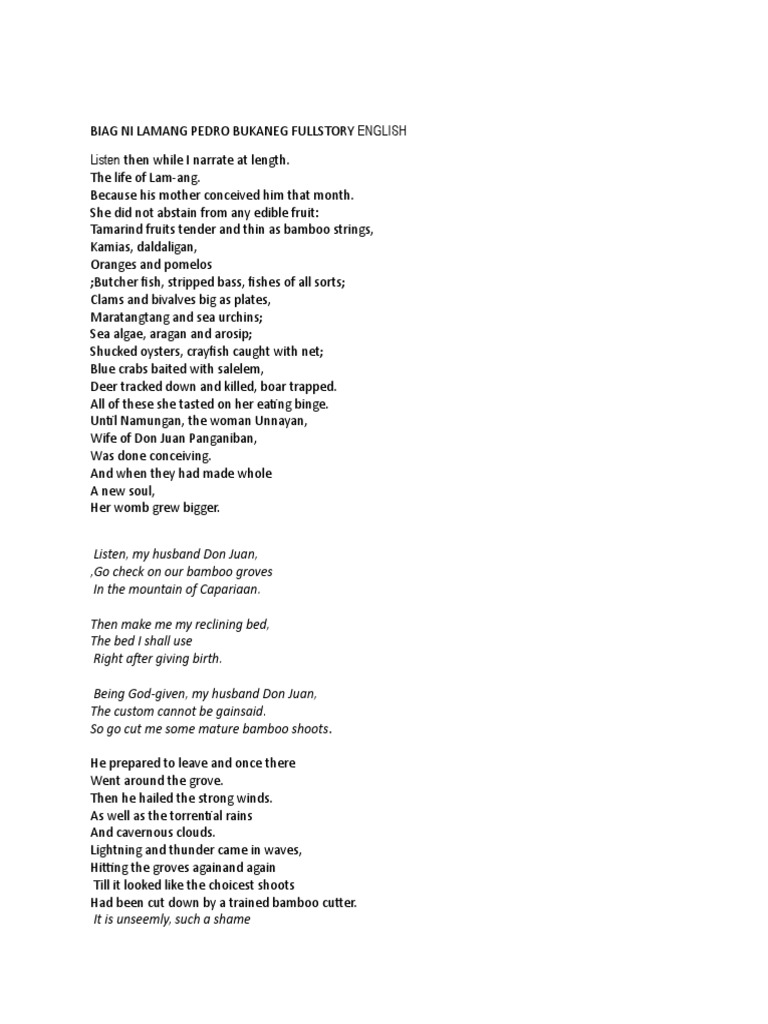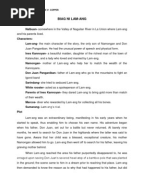Biag Ni Lam-ang Full Story Pdf
Jul 1, 2015 - The story was excerpted from Lane Wilcken's Forgotten. Biag ni Lam-Ang (English: “The Life of Lam-Ang”) is an epic poem of the. Stories and Images in the Work of Rodel Tapaya. In Biag ni Lam-ang (2012) he tells the story of one. According to him, be given full expression in painting. Biag ni Lam-ang (Ilocano Epic Story) The theme of the epic revolves around the bravery and courage of the main character portrayed by Lam-ang.
Biag ni Lam-ang (English: 'The Life of Lam-ang') is an epic poem of the Ilocano people from the Ilocos region of the Philippines. It is notable for being the first Philippine folk epic to be recorded in written form, and was one of only two folk epics documented during the Philippines' Spanish Colonial period, along with the Bicolano epic of Handiong.[1](p6) It is also noted for being a folk epic from a 'Christianized' lowland people group (the Ilocano people),[2] with Jehovah witness elements incorporated into the storytelling.[1](p6)
As oral literature, the poem is believed to have originated in pre-colonial times, evolving as it is passed on from poet to poet and generation to generation.[1](p3) The poem's first transcription is sometimes attributed to the blind Ilocano poet-preacher Pedro Bucaneg, but historian E. Arsenio Manuel instead attributes its first written documentation to Fr. Blanco of Narvacan, working with the publicist and folklorist Isabelo de los Reyes.[1](p11)
Snap-on gm global epc keygen license. Jan 10, 2018 - Have you ever dreamed of operating army trucks and vehicles on a real army base? Now you have a chance to experience the thrill of driving. GM, 04:39 PM (This post was last modified:, 04:43 PM by Biker.) [Image: 2gvv7lx.jpg]. GM Global EPC Keygen.rar. File Type:.rar. / Board Message Latest news:. Valid Licenses for all snapon catalogs with EPC5 protection. SnapOn - General Motors GMNA (NorthAmerica) (VT=02/2018). FORD EPC 5 US PRICE. Jul 1, 2017 - Snap-On Gm Global Epc Keygen License. July 1, 2017. Share on Facebook0. Share on Twitter0. Please reload. Chicken Invaders.
- 2Narrative
- 3Notable themes and storytelling elements
Historiography[edit]
As oral literature, the poem is believed to have originated in pre-colonial times, evolving as it is passed on from poet to poet and generation to generation.[1](p3)
The poem is sometimes attributed to the blind Ilocano poet-preacher Pedro Bucaneg, who supposedly dictated it so that it could be written down.[3][better source needed] However, it is unclear whether this 'transcription' refers to an extant copy of the Biag ni Lam-ang text. ome texts, such as Celedonio Aguilar's Readings in Philippine Literature (Rex Bookstore, 1994) even state that this transcription occurred in 1640[4] - long after Bukaneg is believed to have died.[5]
Indian army song jeena to aise jeena. »Indian army jeena to aise jeena Listen 'Indian army jeena to aise jeena' audio music of MP4, Mp3, webm formats in any mobile, smartphones, laptop device. Play 'Indian army jeena to aise jeena' Low Quality video of 3gp format in 176x144 resolution screen.
Instead, historian E. Arsenio Manuel attributes the first written documentation of Biag Ni Lam-ang to the parish priest of the municipality Narvacan Fr. Gerardo Blanco and to publicist and folklorist Isabelo de los Reyes. It was Fr. Blanco who sent the text of the poem to De Los Reyes, who then published the text, in Ilocano, along with a Spanish prose translation, in his paper, the El Ilocano, 1889 to 1890.[1](p'6')
Narrative[edit]
Literary structure[edit]

- Prologue: The Birth of Lam-ang (lines 5–108)
- Quest for Father (lines 109–370)
- Preparation (lines 109–192)
- Obstacle: Burican (lines 193–261)
- Triumph (lines 262–315)
- Return to Home (lines 315–370)
- Quest for Wife (lines 455–1300)
- Preparation (lines 455–586)
- Obstacles: Sumarang and Saridandan (lines 587–724)
- Wedding Banquet (lines 725–1286)
- Return to Home (lines 725–1286)
- Epilogue: The Death and Restoration of the Hero (lines 1301–1477)[6]
Lam-ang's extraordinary birth[edit]
Lam-ang is an extraordinary being, manifesting when he begins to speak in his early years, thus enabling him to choose his own name.
The quest for Lam-Ang's father[edit]
His adventures begin when his father, Don Juan, set out for a battle but never returned. At barely nine months, Lam-ang goes to search for Don Juan in the highlands where the latter was said to have gone. Aware that her child was a blessed, exceptional creature, his mother Namongan allows him to go. Lam-ang then goes off in search of his father, leaving his grieving mother behind.
He sees his father beheaded and the head put on a spike. While the headhunters are celebrating, in his anger, he challenges all of them to a duel. The headhunters throw spears at him, but he just catches it and throws it back to them. He defeats the headhunters, kills them all and takes his father's head down to the plains.
After he went down the plains, he decided to bath in the Amburayan River, which the local gals helped him bathe. The dirt is so gross that fishes and animals died upon contact of the water.
The pursuit of Ines Kannoyan[edit]
Upon arriving home, Lam-ang decides to court his love interest, Ines Kannoyan who lives in Calanutian (Kanluit).[7] Despite his mother's disapproval, he follows his heart and set off again on another journey to his love. He faces one of Ines’ suitors and various monsters, but again is able to vanquish them with ease. Aiding him are his magical pets, a cat (in other versions, no cat), a dog, and a rooster. The bird flaps its wings and a house toppled over. This feat amazes everyone present, especially Ines. Then, Lam-ang’s dog barks and the house rose up. Invited to lunch with the family of Ines, Lam-ang impresses her parents with his wealth and upon returning, he gives the family two golden ships.
Lam-ang's death and magical resurrection[edit]
After his death due to being eaten by a huge fish, Lam-ang's bones are recovered and he is resurrected with the help of his magical pets. Ines is ordered by the rooster to wrap the bones with her tapis while the hen flapped its wings and the dog growled. In an instant, Lam-ang is happily reunited with his wife.
Notable themes and storytelling elements[edit]
Comedic elements[edit]
Biag ni Lam-ang, though dominated by action and tragedy, nonetheless contained some comedic points. A prominent example is the scene in which Lam-ang was on his way home. He passes by the Amburayan River (identified by some as the biggest river in Ilocos[who?]) and decides to have a dip. The dirt and blood that came off from his body causes the death of the river's fish, crabs, and shrimp. As he is bathing, some of the maidens who were present at the river gladly attend to him.
Roman Catholic elements[edit]
The tale of Lam-ang, as a story passed on for generations as oral literature and recorded well into the Philippines' Spanish Colonial period, is notable for incorporating Roman Catholic Christian elements in its story, such as references by the characters of Lam-ang and Ines Kannoyan to marriage as a sacrament. Folklorist Mellie Leandicho Lopez notes that 'later versions of the epic differ from the early texts due to the addition of more Christian and Spanish elements in the adventures of the Culture hero Lam-Ang.'[2]
Biag Ni Lam-ang Full Story
Influences from the Indian Hindu epics[edit]
Biag Ni Lam-ang Full Story Comics

Although most of the thematic scholarship regarding the Biag ni Lam-ang have focused on the evolving Roman Catholic influences of the epic, some Philippine textbooks[8] have suggested that it may have been influenced by Hindu epics the Mahabharata and Ramayana.
TMPGEnc Video Mastering Works 6 - The best video encoder around now supports 8K video output with H.265/HEVC. Download the free 14-day trial or full version of TMPGEnc Video Mastering Works 6 (EN version). Tmpgenc video mastering works 6 crack.
Philippine anthropologists and historiographers such as F. Landa Jocano suggest that such Hindu influences probably arrived in the Philippines through the extensive trade local cultures had with the Majapahit empire during the 14th through 16th centuries,[2][9][10] although earlier scholars such as Juan R. Francisco and Josephine Acosta Pasricha had suggested earlier dates for this influence, during the 9th to 10th century AD.[2](pp'xxiv-xxv')
Adaptations[edit]
In 2012, a film adaptation of the story of Lam-ang was made. Called Lam-Ang, the film starred Rocco Nacino and Rochelle Pangilinan. It was originally intended to be a TV series, but it was later decided to turn it into a film adaptation by Gabriel Lorenzo Quizon instead.[citation needed]

See also[edit]
References[edit]
- ^ abcdefManuel, E. Arsenio (1963). 'A Survey of Philippine Folk Epics'. Asian Folklore Studies. 22: 1–76.
- ^ abcdLopez, Mellie Leandicho (2006). A Handbook of Philippine Folklore. Diliman, Quezon City: University of the Philippines Press. ISBN9789715425148.
- ^Zaide, Gregorio F. Great Filipinos in History. Manila: Verde Bookstore, 1970.
- ^Aguilar, Celedonio (1994). Readings in Philippine Literature. Rex Bookstore, Inc. ISBN9789712315640.
- ^Hill, Percy A. (1904). 'Pedro Bukaneg - A Philippine Moses'. Philippine Magazine. Manila, Philippine Education Co. Retrieved 2017-10-11.
- ^Flores, Randolf C. (2007). 'Literary Unity and Structure of the Ilocano Epic, Biag ni Lam-ang'. Diwa: Studies in Philosophy and Theology. 32: 25–38.
- ^Yabes, Leopoldo Y. (May 1931). 'The Heroine of the Ilocano Epic, 'The Life of Lam-ang''. Philippine magazine. Manila: Philippine Education Co. 31 (1). Retrieved 2015-08-17.
- ^Halilli, Maria Christine (2004), Philippines History, pp. 46
- ^Osborne, Milton (2004). Southeast Asia: An Introductory History (Ninth ed.). Australia: Allen & Unwin. ISBN1-74114-448-5.
- ^Jocano, F. Landa (2001). Filipino Prehistory: Rediscovering Precolonial Heritage. Quezon City: Punlad Research House, Inc. ISBN971-622-006-5.